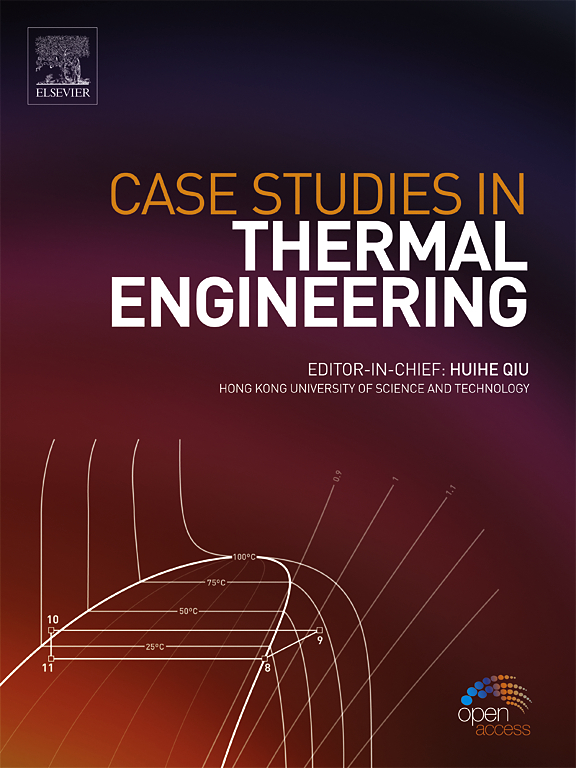气体冷却器上的不均匀气流对跨临界二氧化碳空调性能的影响
IF 6.4
2区 工程技术
Q1 THERMODYNAMICS
引用次数: 0
摘要
由于上游障碍物的影响,汽车跨临界二氧化碳空调中气体冷却器的空气流量和进气温度很容易分布不均。气流分布不均会影响二氧化碳和空气之间的热交换,从而影响空调系统的制冷能力和功耗。本研究通过模拟分析,深入探讨了这种不均匀气流对跨临界二氧化碳空调运行性能的影响。它阐明了不均匀分布模式、不均匀分布方向和不均匀性对跨临界二氧化碳空调系统制冷能力的影响机制。此外,通过解耦不均匀流速和不均匀温度,探讨了增强传热的不均匀气流条件。结果表明,气温分布为 TB-HT(上高下低)和气流速率为 TB-HB(下高上低)的非均匀气流在非均匀度为 55% 时,冷却能力提高了 27.7%。相反,在不均匀度为 40% 的情况下,气流流量和温度分布不均(LR-HL,左高右低)会导致压缩机功率浪费达 1/2。这些发现揭示了不均匀气流对跨临界二氧化碳空调系统性能的双重影响,强调了在设计汽车二氧化碳空调系统时考虑这些影响的重要性。本文章由计算机程序翻译,如有差异,请以英文原文为准。
Impacts of non-uniform airflow over gas cooler on the performance of transcritical CO2 air conditioning
The air flowrate and air inlet temperature over gas cooler in transcritical CO2 air conditioning for vehicles are easily unevenly distributed due to the influence of upstream obstacles. The unevenly distributed airflow affects heat exchange between CO2 and air, thus influencing the cooling capacity and power consumption of the air conditioning system. This study delves into the implications of such non-uniform airflow on the operational performance of transcritical CO2 air conditioning through simulation analysis. It elucidates the mechanisms by which the uneven distribution pattern, uneven distribution direction and non-uniformity affect the cooling capacity of transcritical CO2 air conditioning system. Moreover, the conditions of inhomogeneous airflow for enhanced heat transfer are explored by decoupling inhomogeneous flow rate and inhomogeneous temperature. Results indicate that non-uniform airflow of air temperature distributed as TB-HT (high in top and low in bottom) and air flowrate as TB-HB (high in bottom and low in top) increases the cooling capacity of 27.7 % at non-uniformity of 55 %. Conversely, uneven airflow of flowrate and temperature both distributed as LR-HL (high in left and low in right) at 40 % non-uniformity leads to a wastage of compressor power up to 1/2. These findings reveal the dual impacts of non-uniform airflow on the performance of transcritical CO2 air conditioning system, which emphasizes the importance of considering these impacts when designing automotive CO2 air conditioning systems.
求助全文
通过发布文献求助,成功后即可免费获取论文全文。
去求助
来源期刊

Case Studies in Thermal Engineering
Chemical Engineering-Fluid Flow and Transfer Processes
CiteScore
8.60
自引率
11.80%
发文量
812
审稿时长
76 days
期刊介绍:
Case Studies in Thermal Engineering provides a forum for the rapid publication of short, structured Case Studies in Thermal Engineering and related Short Communications. It provides an essential compendium of case studies for researchers and practitioners in the field of thermal engineering and others who are interested in aspects of thermal engineering cases that could affect other engineering processes. The journal not only publishes new and novel case studies, but also provides a forum for the publication of high quality descriptions of classic thermal engineering problems. The scope of the journal includes case studies of thermal engineering problems in components, devices and systems using existing experimental and numerical techniques in the areas of mechanical, aerospace, chemical, medical, thermal management for electronics, heat exchangers, regeneration, solar thermal energy, thermal storage, building energy conservation, and power generation. Case studies of thermal problems in other areas will also be considered.
 求助内容:
求助内容: 应助结果提醒方式:
应助结果提醒方式:


